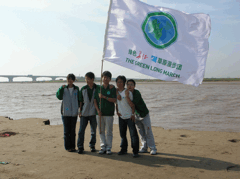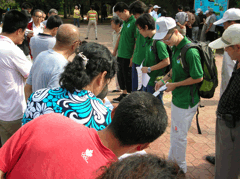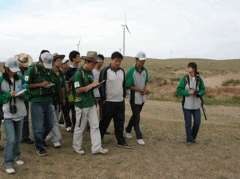Green Long March
Air Date: Week of November 13, 2009

Students on the banks of the Yellow River, just outside Baotou. (Photo: Elise Potaka)
Students from across China are marching in the streets in an effort to mobilize the public to engage in environmental issues and reduce their carbon emissions. During the past few months, more than a thousand students participated in the Green Long March, visiting renewable energy sites and urging rural and city residents to choose energy efficiency, public transportation and plant trees. Elise Potaka joined one group of students in China’s Inner Mongolia and has our report.
Transcript
YOUNG: President Obama is on a tour of Asia, which will include high-level talks on climate change in China. China’s already feeling the effects of a warming world. And while the government positions itself for the upcoming Copenhagen climate summit, some younger Chinese are looking for ways they can address the country’s biggest environmental problems. More than a thousand students are traveling seven routes across China, highlighting energy efficiency and renewable sources of power along the way. It’s known as the Green Long March. Elise Potaka joined one group of marchers in China’s Inner Mongolia.
[VOICES CHANTING SLOGAN, SPEAKING IN CHINESE]
POTAKA: In a small refuge of green in the otherwise heavily industrial Chinese town of Baotou, a group of 15 university students carrying banners winds its way through a local park. “Green Long March, save energy, reduce emissions” they chant.
[STUDENTS TALKING ON LOUDSPEAKER]

Students talk with locals on the streets on Baotou. (Photo: Elise Potaka)
POTAKA: The students are taking part in the northern-most route of what’s become an annual pilgrimage for China’s eco-conscious students – the Green Long March. Over the next two weeks, they’ll wind their way across Inner Mongolia, researching different industries and case studies, and promoting environmental protection.
[VOICE ON LOUDSPEAKER]
POTAKA: With an eye on Copenhagen, this year’s march has focused on promoting energy efficiency and renewables. In the centre of the park, the students set up information stands and a cube which represents the amount of CO2 the average Chinese person emits every four hours. Park-goers – young and old - gather round; the students urge them to choose public transportation over private cars, plant trees, and use energy saving light bulbs.
[MEN TALKING IN CHINESE]
POTAKA: Some in the park are not convinced that “laobaixing” or everyday people can really make a difference. China’s population is just too big, they say. Student leader, Liu Shiyi, counters that this is one of the country’s greatest assets.

At a wind farm, students talk about China’s environmental challenges. (Photo: Elise Potaka)
[SHIYI SPEAKING CHINESE]
VOICEOVER: China’s large population can be seen as a disadvantage, but it also means that if we all work together, we have a lot of power to protect the environment.
POTAKA: Pointing to the brown haze over Baotou, and the factories in the distance, onlooker, Mr. Zhang, says pollution is inevitable as China develops.
[ZHANG SPEAKING CHINESE]
VOICEOVER: In western countries, it’s very common to ban private cars in some parts of the city, and only let buses or police cars move freely. But this is the outcome of a country’s development, and China is just at the beginning. You can't stop these sorts of things now.
POTAKA: But Miki, a journalism student from Beijing disagrees that nothing can be done.
[MIKI SPEAKING CHINESE]
VOICEOVER: Sometimes I think the environment and the economy are in conflict, but our economy has already reached a certain level, and we all understand the importance of environmental protection. Yes, problems exist, but the first step is to realize this and then we can improve the situation. So that’s why our activity today is important.

Students on the banks of the Yellow River, just outside Baotou. (Photo: Elise Potaka)
[VOICES TALKING; PARK ATMOSPHERE]
POTAKA: The Green Long March – now in its third year – is not just about increasing public awareness, it also involves researching different industries and case studies. Most of the students in this group are studying science, and will go on to work in China’s heavy industries – the source of much of the country’s pollution. Industry accounts for around a third of China’s coal use, as well a quarter of its water consumption. Outdated or inefficient technologies continue to hamper environmental progress.
[WIND FARM SOUNDS; VOICES SPEAKING]
POTAKA: A few hours out of Baotou, in the rolling grasslands of the Inner Mongolian steppe, the students arrive at a wind farm. Against a backdrop of massive wind turbines, they ask the owner detailed questions about wind energy. Many of the marchers, like 21-year-old, Liu Shiyi, see the march as a way to find out more about green technologies, which might be able to make a difference in their future workplaces.
[SHIYI SPEAKING CHINESE]
VOICEOVER: After I graduate I might work in a large-scale steel factory. Today’s research will be really useful for me in the future because I’ve discovered that although many steel factories are using technology to reduce their pollution, it’s still not ideal. If I do enter this industry, I hope I can find a find a scientific way to maintain production output as well as protecting the environment.
[PIG SOUNDS; RURAL SOUNDS; STUDENTS TALKING]
POTAKA: Next stop is Quan Feng Village, where the students survey a biogas project that was awarded a small grant as part of the Green Long March. They take detailed notes as village head, Chen Yong Lia, describes the benefits of using pig waste to generate biogas for cooking and heating.
[CHEN SPEAKING CHINESE]

A sign promotes biogas and wind energy near Quanfeng Village. (Photo: Elise Potaka)
VOICEOVER: In the past using coal, we would consume at least 3 tons per year to warm the house and cook food. Now we just need one ton. We also used to burn the wood and corn stalks for energy, but since using biogas we can mulch the stalks or sell them as animal feed.
[FOOTSTEPS; VOICES ECHOING IN KITCHEN]
POTAKA: Villager Lu Haixia turns on the kitchen’s gas cooker to demonstrate the biogas. The students have a lot of questions. Is there any smell, they ask? Does it still work in winter? How much money has the system saved residents? They find that the majority of villagers are using the biogas and are happy with the system.
[STUDENTS SINGING ON BUS]
POTKAK: A bus sing-a-long is just what the group needs to relax at the end of what’s been a busy day. With more than 5,000 students involved more broadly in Green Long March activities, participants, like 22-year-old management student Zuo Ran, are quick to point out that they’re not a minority among people their age.
[ZUORAN SPEAKING CHINESE
VOICEOVER: The people around me have all started to consider the environment. For example, we live in a dormitory. If one person forgets to turn off a tap, someone else will quickly do it. While it’s only a really small action, the important thing is that everyone feels a sense of responsibility.
[VOICES; CLAPPING SOUNDS]
POTAKA: Back in Beijing, at the closing ceremony for the green long march, Zhang Long Shuai, from the Inner Mongolia University of Science and Technology, says it’s important that the Copenhagen climate summit has some real outcomes.
[LONG SHUAI SPEAKING CHINESE]
VOICEOVER: Our carbon emissions have already exceeded the safe level of 350 parts per million. I hope the government does more to advocate public participation in environmental protection, energy-saving and emission reducing activities, and that they implement the policies so it’s not just a conference, or an empty slogan.
POTAKA: Now back in class, the students are busy telling others about what they experienced on their green long march. They hope to draw in new recruits not only to their environmental network, but to the philosophy that underpins it. For Living on Earth, I’m Elise Potaka in Beijing.
Links
Living on Earth wants to hear from you!
Living on Earth
62 Calef Highway, Suite 212
Lee, NH 03861
Telephone: 617-287-4121
E-mail: comments@loe.org
Newsletter [Click here]
Donate to Living on Earth!
Living on Earth is an independent media program and relies entirely on contributions from listeners and institutions supporting public service. Please donate now to preserve an independent environmental voice.
NewsletterLiving on Earth offers a weekly delivery of the show's rundown to your mailbox. Sign up for our newsletter today!
 Sailors For The Sea: Be the change you want to sea.
Sailors For The Sea: Be the change you want to sea.
 The Grantham Foundation for the Protection of the Environment: Committed to protecting and improving the health of the global environment.
The Grantham Foundation for the Protection of the Environment: Committed to protecting and improving the health of the global environment.
 Contribute to Living on Earth and receive, as our gift to you, an archival print of one of Mark Seth Lender's extraordinary wildlife photographs. Follow the link to see Mark's current collection of photographs.
Contribute to Living on Earth and receive, as our gift to you, an archival print of one of Mark Seth Lender's extraordinary wildlife photographs. Follow the link to see Mark's current collection of photographs.
 Buy a signed copy of Mark Seth Lender's book Smeagull the Seagull & support Living on Earth
Buy a signed copy of Mark Seth Lender's book Smeagull the Seagull & support Living on Earth

